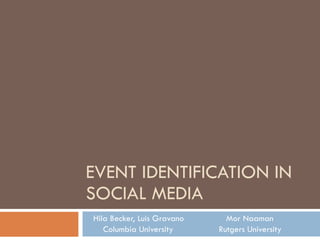Event Identification in Social Media
- 1. EVENT IDENTIFICATION IN SOCIAL MEDIA Hila Becker, Luis Gravano Mor Naaman Columbia University Rutgers University
- 2. Social Media Sites Host Many ŌĆ£EventŌĆØ Documents Photo-sharing: Flickr Video-sharing: YouTube Social networking: Facebook ŌĆ£ EventŌĆØ= something that occurs at a certain time in a certain place [Yang et al. ŌĆÖ99] Popular, widely known events Presidential Inauguration, Thanksgiving Day Parade Smaller events, without traditional news coverage Local food drive, street fair ŌĆ” Social media documents for ŌĆ£All Points WestŌĆØ festival, Liberty State Park, New Jersey, 8/8/08
- 3. Identifying Events and Associated Social Media Documents Applications Event search and browsing Local search ŌĆ” General approach: group similar documents via clustering Each cluster corresponds to one event and its associated social media documents
- 4. Event Identification: Challenges Uneven data quality Missing, short, uninformative text ŌĆ” but revealing structured context available: tags, date/time, geo-coordinates Scalability Dynamic data stream of event information Unknown number of events Necessary for many clustering algorithms Difficult to estimate
- 5. Clustering Social Media Documents Social media document representation Social media document similarity Social media document clustering Clustering task: definition Ensemble algorithm: combining multiple clustering results Preliminary evaluation
- 6. Social Media Document Representation Title Description Tags Date/Time Location All-Text
- 7. Social Media Document Similarity Text: tf-idf weights, cosine similarity Title Description Tags Date/Time Location All-Text Title Description Tags Date/Time-Keywords Location-Proximity All-Text Location-Keywords Date/Time-Proximity time Location: geo-coordinate proximity A A A B B B Time: proximity in minutes
- 8. Social Media Document Clustering Framework Document feature representation Social media documents Event clusters
- 9. Clustering: Ensemble Algorithm Consensus Function: combine ensemble similarities W title W tags W time f(C,W) C title C tags C time Ensemble clustering solution Learned in a training step
- 10. Clustering: Measuring Quality Homogeneous clusters Ō£ö Ō£ö Complete clusters Metric: Normalized Mutual Information (NMI) Shared information between clustering solution and ŌĆ£ground truthŌĆØ
- 11. Experimental Setup Data: >270K Flickr photos Event labels from Yahoo!ŌĆÖs ŌĆ£upcomingŌĆØ event database Split into 3 parts for training/validation/testing Clusterers: single pass algorithm with centroid similarity Weighing scheme: Normalized Mutual Information (NMI) scores on validation set Consensus function: weighted average of clusterersŌĆÖ binary predictions Final prediction step: single pass clustering algorithm
- 12. Preliminary Evaluation Results Individual clusterer performance Highest NMI: Tags, All-Text Lowest NMI: Description, Title Ensemble performance, compared against all individual clusterers Highest overall performance in terms of NMI More homogenous clusters: each event is spread over fewer clusters Details in paper
- 13. Document similarity metric Ensemble approach Weight assignment Choice of clusterers Train a classifier to predict document similarity Features correspond to similarity scores All-text, title, tags, time, location, etc. Numeric values in [0,1] State-of-the-art classifiers: SVM, Logistic Regression, ŌĆ” Future Work: Alternative Choices
- 14. Future Work: Alternative Choices Final clustering step Apply graph partitioning algorithms Requires estimating the number of clusters Evaluation metrics: beyond NMI Datasets Flickr LastFM, YouTube Exploit social network connections
- 15. Conclusions Identified events and their corresponding social media documents Proposed a clustering solution Leveraged different representations of social media documents Employed various social media similarity metrics Developed a weighted ensemble clustering approach Reported preliminary results of our event identification approach on a large-scale dataset of Flickr photographs
Editor's Notes
- #3: Social media sites host a variety of event information We use the traditional event definition from the event detection literature, stating that an event isŌĆ”, In particular, we consider events that range from ŌĆ”
- #4: Our goal is toŌĆ” This could facilitate application such asŌĆ” as can be seen in this image, similar to news aggregation sites but for events, including a variety of rich media content Our approach for even identification uses clustering to group similar event documents, such thatŌĆ”
- #5: Social media data quality is uneven When developing our approach, we had to consider the scalability of our algorithms as there exists a vast amount of social media event data on the web
- #6: Define and motivate the event identification taskŌĆ”
- #8: We have different notions of similarity for different types of featuresŌĆ” We have to come up with a principled way to combine these different notions into a single similarity
- #10: We can cluster out document collection according to the variety of feature reps. discussed, each would have its own
- #12: Mention briefly where the event IDs came fromŌĆ”
- #14: IŌĆÖll add a note on where these experiments stand
- #15: Backup slide


![Social Media Sites Host Many ŌĆ£EventŌĆØ Documents Photo-sharing: Flickr Video-sharing: YouTube Social networking: Facebook ŌĆ£ EventŌĆØ= something that occurs at a certain time in a certain place [Yang et al. ŌĆÖ99] Popular, widely known events Presidential Inauguration, Thanksgiving Day Parade Smaller events, without traditional news coverage Local food drive, street fair ŌĆ” Social media documents for ŌĆ£All Points WestŌĆØ festival, Liberty State Park, New Jersey, 8/8/08](https://image.slidesharecdn.com/webdb09-final-091012121712-phpapp01/85/Event-Identification-in-Social-Media-2-320.jpg)










![Document similarity metric Ensemble approach Weight assignment Choice of clusterers Train a classifier to predict document similarity Features correspond to similarity scores All-text, title, tags, time, location, etc. Numeric values in [0,1] State-of-the-art classifiers: SVM, Logistic Regression, ŌĆ” Future Work: Alternative Choices](https://image.slidesharecdn.com/webdb09-final-091012121712-phpapp01/85/Event-Identification-in-Social-Media-13-320.jpg)

